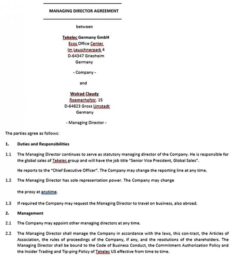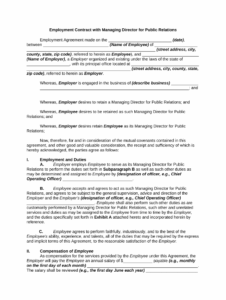When a nonprofit organization finds its visionary leader, the Executive Director, it’s a truly exciting moment. This individual will steer the ship, inspire the team, and drive the mission forward. However, amidst the enthusiasm, there’s a crucial step that often gets overlooked or rushed: formalizing the employment relationship with a clear, comprehensive contract. A well-defined agreement isn’t just a formality; it’s the bedrock of a successful, transparent, and long-lasting partnership between the organization and its leader.
Understanding the intricacies involved in this critical document can save countless headaches down the line. That’s why having access to a solid nonprofit executive director contract template is incredibly valuable. It provides a structured framework to ensure all parties are aligned on expectations, responsibilities, compensation, and the terms of engagement, protecting both the organization’s interests and the Executive Director’s professional well-being.
Crafting a Robust Nonprofit Executive Director Contract
Developing an Executive Director contract for a nonprofit isn’t just about putting pen to paper; it’s about building a foundation for a successful working relationship that aligns with the organization’s mission and values. A robust contract serves as a roadmap, detailing every aspect of the employment relationship, from day-to-day duties to long-term performance goals and eventual exit strategies. It anticipates potential issues and provides clear solutions, fostering trust and minimizing misunderstandings.
Think of the contract as a comprehensive agreement that protects both the nonprofit and its Executive Director. It clarifies the scope of authority, delineates reporting relationships, and sets the stage for how success will be measured. Without such a document, ambiguity can creep in, leading to conflicts or inefficiencies that can distract from the important work of the organization. This isn’t just a legal necessity; it’s a strategic tool for good governance.
Core Elements to Include
To ensure your contract is as comprehensive as possible, you’ll want to cover several key areas. These elements are vital for clarity and protection.
- Job Description and Scope of Authority: Clearly define the Executive Director’s roles, responsibilities, and the extent of their decision-making power. What are their daily tasks? What strategic initiatives are they responsible for? Where do their responsibilities end and the Board’s begin?
- Compensation and Benefits Package: Detail the annual salary, any bonuses or incentives, health insurance, retirement plans, paid time off, and other perquisites. Transparency here is paramount to attract and retain top talent.
- Performance Review Metrics: How will the Executive Director’s performance be evaluated? Include key performance indicators (KPIs) aligned with the organization’s strategic goals and mission. This ensures objective assessment.
- Confidentiality and Intellectual Property: Clauses protecting sensitive organizational information and ensuring that any intellectual property developed during employment belongs to the nonprofit.
- Termination Clauses and Severance: Outline the conditions under which the contract can be terminated, by whom, and with what notice. This should include provisions for termination with and without cause, and any severance packages.
Beyond these core elements, it’s crucial to elaborate on the reporting structure. Will the Executive Director report directly to the Board of Directors, a specific committee, or the Board Chair? Defining this helps prevent communication breakdowns and ensures accountability. It’s also important to detail how performance will be reviewed, including the frequency and process of evaluations, ensuring that performance discussions are constructive and goal-oriented, rather than subjective.
Furthermore, a well-drafted contract should address the organization’s policies regarding conflicts of interest. Executive Directors often interact with various stakeholders, and clear guidelines help maintain the integrity and reputation of the nonprofit. By thoroughly addressing these components, you create a document that supports the Executive Director in their role while safeguarding the organization’s mission and assets.
Navigating the Legal Landscape and Best Practices for ED Contracts
When preparing an Executive Director contract, it’s not enough to simply fill in the blanks of a template. Nonprofits must also navigate a complex legal landscape, which can vary significantly depending on jurisdiction. State and federal employment laws, tax regulations, and nonprofit-specific governance requirements all play a crucial role in shaping the final document. Failing to consider these legal nuances can expose the organization to unnecessary risks, including legal challenges, financial penalties, or damage to its reputation. Therefore, consulting with legal counsel experienced in nonprofit law is an invaluable step to ensure compliance and proper protection for all parties.
The Board of Directors holds the ultimate responsibility for hiring, evaluating, and, if necessary, terminating the Executive Director. Their role in contract negotiation and approval cannot be overstated. The process should be transparent, fair, and based on objective criteria, reflecting the board’s fiduciary duties to the organization. This often involves a compensation committee or a dedicated board committee reviewing salary benchmarks and contract terms to ensure they are reasonable and competitive, while also being mindful of the nonprofit’s financial health and mission.
Specific clauses within the contract, such as those detailing “cause” for termination or outlining severance agreements, demand careful attention. What constitutes “cause” must be clearly defined to avoid ambiguity if a difficult situation arises. Similarly, severance packages should be fair and reasonable, aligning with industry standards and the organization’s capacity. These provisions are not just legal safeguards; they also contribute to a sense of security for the Executive Director and provide clarity for the board during potentially challenging transitions.
Ultimately, an Executive Director contract should be viewed as a living document. It’s not a one-time agreement that gathers dust after signing. Best practices dictate that the contract should be reviewed periodically, perhaps every few years or upon significant changes in the organization’s structure, mission, or the Executive Director’s responsibilities. This ensures that the terms remain relevant, fair, and legally sound, adapting to the evolving needs of both the individual and the nonprofit.
A thoughtfully constructed employment agreement is more than just a piece of paper; it’s a strategic investment in the stability and future success of your nonprofit. It fosters a professional environment built on mutual understanding and clear expectations, allowing the Executive Director to focus wholeheartedly on advancing the organization’s mission without unnecessary distractions or uncertainties.
By dedicating the time and resources to develop a robust and legally sound contract, your organization sets the stage for a strong, resilient, and enduring leadership partnership. Using a reliable nonprofit executive director contract template as your starting point, and then customizing it with expert legal input, is a wise move for any organization committed to its long-term impact and effective governance.



